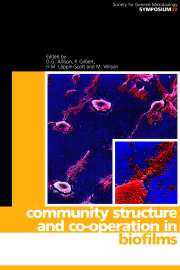Book contents
- Frontmatter
- Contents
- Contributors
- Editors' Preface
- An overview of biofilms as functional communities
- Initial microbial adhesion events: mechanisms and implications
- Physiological events in biofilm formation
- Environmental and genetic factors influencing biofilm structure
- Coaggregation and coadhesion in oral biofilms
- Cohesiveness in biofilm matrix polymers
- Microbial detachment from biofilms
- Modelling and predicting biofilm structure
- Microbial community interactions in biofilms
- Microbial communities: aggregates of individuals or co-ordinated systems
- Gene transfer in biofilms
- Population dynamics in microbial biofilms
- Biodegradation by biofilm communities
- Biofilms and prosthetic devices
- Biofilms: problems of control
- Biofilms in the New Millennium: musings from a peak in Xanadu
- Index
Physiological events in biofilm formation
Published online by Cambridge University Press: 03 June 2010
- Frontmatter
- Contents
- Contributors
- Editors' Preface
- An overview of biofilms as functional communities
- Initial microbial adhesion events: mechanisms and implications
- Physiological events in biofilm formation
- Environmental and genetic factors influencing biofilm structure
- Coaggregation and coadhesion in oral biofilms
- Cohesiveness in biofilm matrix polymers
- Microbial detachment from biofilms
- Modelling and predicting biofilm structure
- Microbial community interactions in biofilms
- Microbial communities: aggregates of individuals or co-ordinated systems
- Gene transfer in biofilms
- Population dynamics in microbial biofilms
- Biodegradation by biofilm communities
- Biofilms and prosthetic devices
- Biofilms: problems of control
- Biofilms in the New Millennium: musings from a peak in Xanadu
- Index
Summary
INTRODUCTION
Bacteria have been shown to exist predominantly in nature as sessile populations attached to surfaces in contact with water (Geesey et al., 1977). The numbers of bacteria attached to surfaces have been estimated to be between 1000 and 10000 times greater than the numbers of planktonic bacteria in any given environment (Watkins & Costerton, 1984).
The advantages to the micro-organisms of being attached to a surface have been largely attributed to enhanced scavenging of nutrients from both the bulk water and from the substratum with which the bacteria are associated (Marshall, 1976). Microorganisms at surfaces are considered to be exposed to higher nutrient conditions than their planktonic counterparts and, therefore, are at an advantage in the attached state. As a demonstration of this, Kjelleberg et al. (1982) exposed starved planktonic and attached marine bacteria to 2 mg l−1 of both yeast extract and tryptone. The attached population was able to grow under low nutrient conditions, while the planktonic population was not. Further investigations revealed that when adsorbed to surfaces, both low (Power & Marshall, 1988) and high (Samuelsson & Kirchman, 1990) molecular mass compounds were available for microbial growth. These and other studies strengthened the idea that differences in growth rates of surface-associated bacteria and planktonic bacteria were primarily due to differences in nutrient availability. Thus attached bacteria, while nutritionally at an advantage over their planktonic counterparts, have for many years been considered to be similar in other respects to non-attached bacteria.
Continued research began to expose differences between planktonic and attached bacteria that implied physiological alterations following attachment to a surface.
- Type
- Chapter
- Information
- Community Structure and Co-operation in Biofilms , pp. 37 - 52Publisher: Cambridge University PressPrint publication year: 2000
- 9
- Cited by



